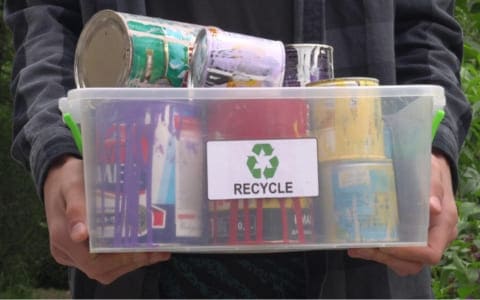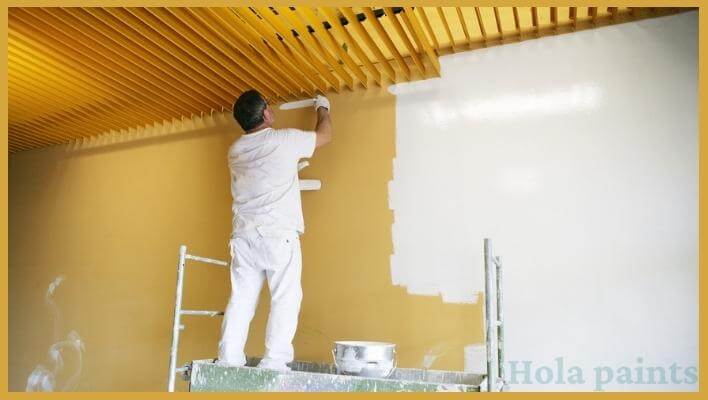When it comes to transforming the look and feel of our living spaces, latex paint stands out as a popular choice for homeowners and DIY experts alike. Latex paint is often used because it’s easy to work with, but is it flammable?
In this article, we’ll break down the basics of latex paint and see if there’s any risk of it catching fire. Whether you’re new to painting or a DIY pro, understanding if latex paint is flammable is important for a safe and worry-free home improvement project.
Table of Contents
- Is latex paint flammable or not?
- What do you mean by Flammability?
- Is combustion the same as flammable?
- Is Latex Paint Flammable or Combustible?
- Informative Guide to Flammable Paints: Types, Risks, and Safety Measures
- Is latex paint biodegradable?
- Are latex paint fumes safe?
- Is Wet Latex Paint Flammable?
- Does heat affect latex paint?
- Can you bake latex paint to cure it?
- How to Dispose of Flammable Paints?
- Is it OK to put latex paint down the drain?
- Conclusion:
- Martina Hitchcock
Is latex paint flammable or not?

Latex paint is classified as non-flammable due to its water-based composition with minimal flammable solvents. Unlike oil-based paints, which are considered flammable, latex paint is less prone to catching fire under normal conditions. Its inherent non-flammability is attributed to the absence of rubber or latex and the use of water as a solvent.
The flash point of latex paint, exceeding 200°F (93ºC), further contributes to its resistance to ignition in typical scenarios. However, it’s important to note that when subjected to open flames or high heat, latex paint can still pose a fire risk. Special precautions should be taken, especially with latex paint spray cans, which may contain flammable compounds.
What do you mean by Flammability?
The ease with which something can catch fire and burn when heated is known as flammability. It shows how quick and intense the burning can be. Things that are very flammable need extra attention because they can catch fire fast. When a substance is flammable, it means it can easily catch fire from things like flames or sparks.
The flash point is the lowest temperature at which a substance can ignite when it comes into contact with something hot. Flammable things can burn easily at regular temperatures, and they can be risky for causing fires. So, it’s important to handle and store them carefully to avoid accidents and reduce the chance of unexpected fires. Some examples of flammable stuff include paper, gas, and rubber.
Is combustion the same as flammable?
Flammable liquids can catch fire at regular temperatures, while combustible liquids need more heat to ignite. Although people often use “flammable” and “combustible” interchangeably, there’s a subtle difference.
Substances that are flammable, having a low flash point, easily ignite when subjected to heat. In contrast, combustible materials have a higher flash point and require elevated temperatures to release vapors and ignite.
Combustible materials, such as aluminum, coal, and specific types of paint, demand more effort to burn and don’t easily catch fire at typical working temperatures. It’s crucial to understand this difference for safety and handling purposes.
Is Latex Paint Flammable or Combustible?
Latex paint falls into the combustible category due to its higher flash point, indicating that it demands more heat for ignition compared to substances classified as flammable. This implies that under normal working conditions, latex paint is less prone to catching fire spontaneously. Despite being combustible, it’s crucial to handle latex paint with care, follow safety guidelines, and store it appropriately to mitigate any potential risks associated with its combustible nature.
Note: learn more about the flammability of acrylic paints.
Informative Guide to Flammable Paints: Types, Risks, and Safety Measures
| Paint Category | Description |
| Flammable Paint Types | Solvent-based paints, including oil-based, lacquers, and enamels, are susceptible to combustion due to the presence of volatile solvents, posing fire hazards. Latex paint, being water-based, is non-flammable and considered safer in this regard. |
| Factors Making Paint Dangerous | Solvent-based paints carry a risk of ignition. Inhalation of fumes from certain paints can result in health issues. Some paints contain hazardous substances. |
| Chemicals in Flammable Paint | Key flammable paint chemicals include toluene, xylene, acetone—volatile solvents enhancing the paint’s flammability. |
| Safety Tips for Working with Flammable Paints | Ensure proper airflow in work areas. Use gloves and masks for protection against chemical exposure. To prevent fire hazards, it’s important to keep paints away from open flames and heat sources. Store paints in cool, dry places, away from potential ignition sources. |
Is latex paint biodegradable?
Latex paint is considered environmentally friendly due to its lower volatile organic compounds (VOCs) compared to oil-based paints. The reduced VOC content makes it a preferred choice for eco-conscious consumers. Environmental Protection Agency guidelines restrict the VOC content in latex paints to 250 grams per liter, contributing to its non-toxic nature.
Despite its eco-friendly characteristics, some latex paints contain chemicals harmful to aquatic life. Additionally, certain formulations may include lead or mildew-preventing additives, introducing potential environmental concerns. It is crucial to be aware of the specific composition of latex paints and choose formulations that align with environmentally responsible practices to ensure minimal impact.
Are latex paint fumes safe?
Latex paints are composed of water-based formulations and exhibit flash points exceeding 200°F (93ºC). This characteristic makes them less susceptible to fire or explosion risks in comparison to solvent-based paints.
In the case of latex paints, their high flash points mean that the concerns related to fire hazards, explosions, and the potential for vapors reaching an ignition source in a workshop setting are minimal. This property enhances the overall safety profile of latex paints, making them a preferred choice in environments where flammability risks are a significant consideration.
Is Wet Latex Paint Flammable?
Wet latex paint is generally not flammable due to its water-based composition. Unlike oil-based paints, which are flammable when wet, latex paint poses minimal flammable risks in its wet state. However, it’s important to note that once latex paint dries, it can become combustible.
The water content in latex paint contributes to its non-flammable nature when wet. To ensure safety, it’s crucial to handle wet latex paint with care, avoiding exposure to open flames or high heat sources. Additionally, proper disposal methods for latex paint should be followed to enhance safety and environmental considerations.
Does heat affect latex paint?
Latex paint is good in regular room temperatures, but if it gets too hot, problems can happen. It might not stay stable and could even catch fire. The exact temperature for burning depends on how long it’s exposed to heat and what’s in the paint.
When it faces strong heat or flames, bad things can occur. It might give off harmful fumes, get soft, bubble, or change color. The water inside evaporates, leaving solid parts that can’t handle the high heat.
To keep latex paint in good shape, store it in a cool, dry place, and use it when the weather is just right. This helps avoid issues caused by too much heat.
Can you bake latex paint to cure it?
Putting latex paint in the oven is strongly discouraged. The formulation and ingredients of latex paint are not designed to withstand high temperatures, and doing so can create a fire hazard. Heating can lead to the breakdown of the paint’s chemical structure, compromising its quality and appearance on painted surfaces. It may also result in the paint becoming thinner.
Furthermore, heating latex paint causes volatile components to evaporate, releasing toxic fumes into the air. In addition to environmental harm, inhaling the fumes released when heating latex paint can pose respiratory risks. To ensure the safety and quality of your painting projects, it’s important to follow proper curing methods recommended by the paint manufacturer, avoiding any attempts to accelerate the process through methods like oven heating.
How to Dispose of Flammable Paints?

| Disposal Method | Description |
| Adherence to Local Regulations | Ensure compliance with local disposal regulations, which may provide specific guidelines for the proper disposal of flammable paints. |
| Drying Out Process | For smaller quantities, facilitate complete drying by leaving the paint container open in a well-ventilated area. Once dried, dispose of it with regular household trash. |
| Professional Disposal Services | Contact local waste management or specialized hazardous waste disposal services for larger quantities or when regulations mandate professional handling. |
| Exploration of Recycling Programs | Investigate paint recycling initiatives in your locality that accept unused or residual paint for appropriate disposal or recycling. |
| Donation Opportunities | Consider donating unused paint to community organizations, schools, or individuals in need, ensuring it meets the required condition and donation guidelines. |
| Participation in Special Collection Events | Engage in designated household hazardous waste collection events organized by local authorities to safely dispose of flammable paint and other hazardous materials. |
Is it OK to put latex paint down the drain?
Don’t pour latex paint down the drain because it can harm the environment. If you have a bit left, let it dry completely, then throw it in the regular trash. You can also mix it with paint hardener or kitty litter to speed up drying. Always check local rules—they might tell you how to toss dried latex paint, and sometimes it’s okay in regular trash.
Conclusion:
In summary, when latex paint is fully dried, it is generally perceived as non-flammable. The absence of flammable solvents in its water-based composition makes it a safer option compared to oil-based paints. However, it’s important to handle the storage and disposal of latex paint properly to avoid potential fire hazards. Following recommended guidelines for storage and disposal ensures a safer experience with latex paint.

Martina Hitchcock
Martina Hitchcock is a versatile author with expertise in different fields. As a paint sprayer expert, she has in-depth knowledge of paint spraying techniques, tools, and equipment. Martina is also an experienced home remodeler who has worked on various projects, including kitchen and bathroom renovations, flooring installations, and room additions. Her knowledge of home improvement and remodeling is extensive, and she enjoys sharing her insights and tips with readers. You can follow her on Facebook.


